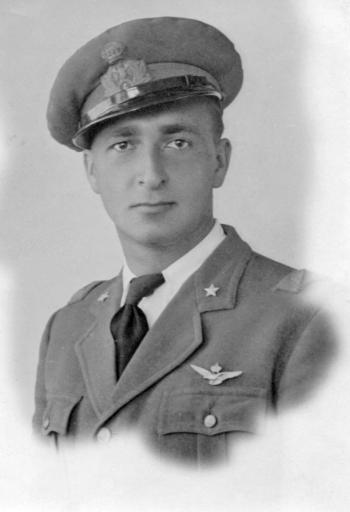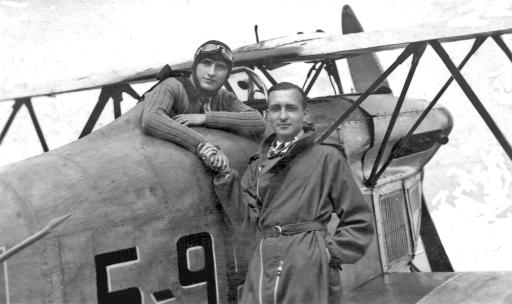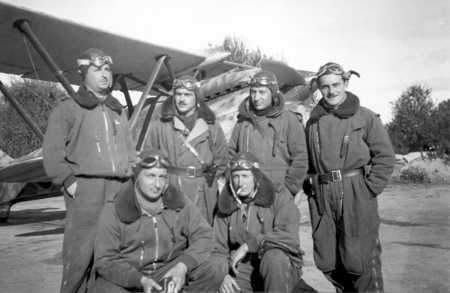Italy

Tenente Silvio Costigliolo
Italy

Tenente Silvio Costigliolo
23 June 1909 – October 1964
| Date | Decoration | Note |
| ??/??/38 | Medaglia d’argento al valor militare (1st) | O.M.S. |
| ??/??/38 | Medaglia d’argento al valor militare (2nd) | O.M.S. |
| ??/??/?? | Medaglia di bronzo al valor militare | O.M.S. |
| ??/??/42 | Croce al merito di guerra | 1940-43 |
| ??/??/?? | Medaglia commemorativa della campagna di Spagna (1936-1939) | O.M.S. |

Image kindly provided by Fulvio Chianese at GORIZIA ed il QUARTO STORMO.
Silvio Costigliolo was born in Genoa on 23 June 1909.
He joined the Regia Aeronautica in 1929.
He was posted to the 96 a Squadriglia, IX Gruppo, 1o Stormo at Aviano. In Ocotber, the unit moved to Campoformido in September 1931, the Gruppo was assigned to the newly formed 4o Stormo at Gorizia.

Costigliolo together with an unidentified pilot, along with a Fiat CR.1 of the 96a Squadriglia.
Image kindly provided by Fulvio Chianese at GORIZIA ed il QUARTO STORMO.
On 10 January 1932, Tenente Anotnio Colla and Costigliolo suffered an air-to-air collision during a training flight over Cormons. Costigliolo parachuted safely but Collo followed his aircraft into the ground and was killed.
In October 1936, he volunteered for the Spanish Civil War using the name Silvio Castiglini.
He was assigned to the Squadriglia ’Cucaracha’.
With the arrival of more pilots and aircraft, the Squadriglia ’Cucaracha’ was dissolved and Costigliolo was assigned to the 1a Squadriglia (CO Capitano Enrico Degli Incerti) of the I Gruppo (CO Maggiore Tarcisio Fagnani).
On 12 November, he scrambled from Torrijos and claimed a shared SB (identified as a ‘Martin bomber’) over the base.

Pilots from the 1a Squadriglia of the Aviazione Legionaria, at Torrijos, Spain, January 1936.
From left: Sergente Sirio Salvadori (’Salvo’), Tenente Enrico Degli Incerti (’Tocci ’), Oreste Minuto (’Proietti ’), Sergente Giuseppe Ruzzin (’Grazzi ’)
Front row: Sergente Maggiore Costigliolo (’Castiglini ’) and Sergente Bruno Castellani (’Ribaudo ’).
Image kindly provided by Fulvio Chianese at GORIZIA ed il QUARTO STORMO.
In the afternoon on 16 February, 24 CR.32s flew close escort to Ju 52/3ms out to bomb Arganda del Rey. Polikarpov I-15s intercepted them from behind and above. The Republican fighters didn’t attack the Nationalist aircraft but over the target three I-15s broke formation and raced towards the bombers. Before the escort could intervene, one Ju 52/3m bomber flown by a Spanish crew was shot down. Banking sharply to the port, Tenente Enrico Degli Incerti intercepted the leader of the I-15s and opened fire. This prompt action caused the enemy pilot to discontinue the attack, but as he tried to evade Degli Incerti, he presented an excellent target. Degli Incerti saw his bullets disappearing in the I-15s fuselage and he remained behind it, sending burst after burst into it until it began to burn. He then followed it down until it hit the ground. The shot down I-15 was also as confirmed by observers from the tri-motor formation.
It seems that Sergente Maggiore Costigliolo claimed a I-16 during the same mission since he claimed one of Russian monoplanes (reported as a ‘Boeing’) south of Arganda, during an escort mission of Junkers Ju 52/3ms and IMAM Ro.37 bombers.
I-16s from Escuadrilla Tarkhov also took part in this interception when Leitenant Andrei Morozov and Leitenant Petr Khara claimed a CR.32 each and leitenant Sergey Denisov claimed a Ju 52 3/m.
It seems that Frank Tinker of the Escuadrilla La Calle was shot down during this combat.
One Nationalist Ju 52 3/m was lost with its Spanish crew; capitán Jose Calderon Katseli, tenente Francisco Taillefer and sargento Felipe Rojas Gomez were killed while the other two crew members were captured.
In the early morning on 18 February, two Nationalist Ro.37s (flown by Spanish pilots) took off, followed by three Ju 52/3ms escorted by the Spanish Patrulla Azul and the Italian Fiat Group (totally 25 CR.32 including the Spanish). When they arrived over the front at Jarama, the CR.32s turned so that they were patrolling parallel to the front, while a large formation of Polikarpov fighters waited on the other side. When the Ro.37s and Ju 52/3ms were safe and returning, capitán Joaquín García Morato broke formation and, followed by teniente Julio Salvador Díaz-Benjumea and capitán Narciso Bermúdes de Castro, launched himself into Soviet fighters near Arganda. Disregarding recent orders restricting them from engaging superior numbers of enemy aircraft, Italian pilots tenente Corrado Ricci, tenente Enrico Degli Incerti, capitano Guido Nobili and Fiacchino went to the assistance of their Spanish comrades by leading their respective flights against the large Republican formation of Polikarpov fighters. Finally, the entire group took part in the battle, fighting a reportedly 21 I-15s and 18 I-16s, and the Italians claimed for four ”Curtiss fighters” destroyed and four probables, as well as four Ratas destroyed and one probables. One I-16 and two probable I-15s were claimed by tenente Degli Incerti while sergente maggiore Costigliolo claimed an I-15 in the Arganda area. Sergente maggiore Guido Presel claimed two I-15s and a probable and sergente maggiore Brunetto di Montegnacco claimed two I-16s. Among the Spaniards, capitán Morato, who returned with damage to his fighter, was credited with an I-15 and another as a probable while teniente Salvador was credited with and I-16 and a second fighter as a probable.
The Italians suffered no losses during this action, and only a solitary pilot was forced to make an emergency landing after he was wounded; the damage to his CR.32 was quickly repaired.
Tenente Degli Incerti described the combat:
“We were on the return leg of an escort mission, and having made sure that our bombers were safe, we had the airfield in sight and prepared to land. It was at that very moment that the three Spanish CR.32 pilots following us, but still flying over enemy territory, decided to take on a large Soviet formation. Although the enemy aircraft were still some distance away, we performed a hasty 180-degree turn at full throttle and joined the fray. All the Italian fighter flights following suit, despite us having orders only to intervene following provocation – our duty was to fight as courageously as possible to the end.Reportedly this battle was fought at 11:00 against at least the I-15s of the Escuadrilla La Calle and Escuadrilla José (the Escuadrilla led by Ivan Kopets) and the I-16s from Escuadrilla Kolesnikov (1a/21). The Republican pilots reported meeting six ”Junkers” and 50 fighters (other sources states 85 (!) Heinkel He 51s) over the front. Immediately the Escuadrilla went into a tight horizontal circle (”Lufbery circle”). The first enemy aircraft fired randomly at the I-15s as they dived past the Escuadrilla’s defensive pattern. Unwillingly to challenge the Republican fighters, the remainder of the Nationalist pilots followed suit, executing a single strafing pass, and then flying lazily below the I-15s in hopes of enticing a few green Republican pilots away of the defensive protection. Ben Leider took the bait and started down after one of the easy-looking targets, only to attract three enemy fighters on his tail. As Frank Tinker peered over his shoulder during the swirling melee of aircraft, he saw Leider’s I-15 to shudder as the CR.32s flashed past. Tinker’s heart sank as he noticed Leider veer toward friendly territory in a shallow dive. Twice, Leider tried to land his fighter in a small field before slamming into the side of a hill, killing him.
Once we had engaged the enemy, both sides formed a long line of aircraft, and this was turning, banking and circling. The fighters alternated in this single file trail, with two or three “Reds” for every Nationalist. It was as if this formation had been planned. Many tracer rounds flashed through the sky from the aircraft, turning the dogfight into an infernal ballet. Smoke trails of death suddenly appeared, and the long line broke into smaller rows.
The battle threw up numerous small skirmishes that ended inconclusively. Despite being outnumbered, we legionnaires stood together, compact, protecting each other. All of a sudden in the centre of the melee an aircraft caught fire and a parachute opened. The former fell away and crashed to the ground, while the latter floated away to safety. A “Red” had been shot down. Four of his comrades, fearing that we'd shoot at the pilot, circled him for his protection. Two CR.32s engaged them. This turn of events split the battle into two groups, within which fierce fighting continued.
The “Curtiss fighter” section then broke off their attack, unable to defeat our concentrated gunfire. They tried to escape, but this move failed and two of the stubby fighters fell in flames.
Thirty minutes into the battle, thousands of bullets had crossed the sky over Villaconejos. By now the revolving aircraft and chatter of the guns had diminished. The fighting faded slowly away, and within a short time we remained as the sole masters of the sky over the Jarama front.”
Between 14:20 and 15:40 on 20 February, Sergente Maggiore Costigliolo claimed an I-16 over Morata de Tajuna during an escort mission of Ju 52/3m bombers. Tenente Corrado Ricci of the 3a Squadriglia claimed a shared victory (Curtiss?) together with eight other Italian pilots during the same mission,
On 22 April, the 1a Squadriglia was renamed to the 19a Squadriglia when the XXIII Gruppo Caccia Aviazione Legionaria was reformed.
Later he was transferred to the 31a Squadriglia, VI Gruppo.
In June 1937, Costigliolo returned to Italy.
During his service in Spain he was credited with three victories and awarded with two Medaglie d’Argento al valor militare, one Medaglia di bronzo al valor militare and the Medaglia commemorativa della campagna di Spagna.
By 1938, he was promoted Maresciallo for war merits.
In December 1939, he and his friends Marescialli Giuseppe Avvico and Giuseppe Biron, decided to try the Accademia Aeronautica (Officers Academy) and all three were commissioned as Sottotenenti on 9 May 1941.
During the Second World War, he served in the 393a Squadriglia, 160o Gruppo, flying CR.42s and later Fiat G.50s.
After 15 months fighting in the North Africa campaign, he was promoted to Tenente on 13 November 1942 and awarded with the Croce al merito di guerra.
After two years in Africa, he joined the Scuola Pilotaggio in Gorizia.
After the Italian surrender in September 1943, he joined the A. N. R. (Aeronautica Nazionale Repubblicana).
Costigliolo ended the war with 3 biplane victories.
After the war, in 1947, he emigrated from Italy after being almost expelled from the Aeronautica Militare as an adherent to the A. N. R.
Costigliolo passed away in Buenos Aires, Argentina, in October 1964
Claims:
| Kill no. | Date | Time | Number | Type | Result | Plane type | Serial no. | Locality | Unit |
| 1936 | |||||||||
| 12/11/36 | 1 | SB | Shared destroyed | Fiat CR.32 | Torrijos | 1a Escuadrilla de Caza del Tercio | |||
| 1937 | |||||||||
| 1 | 16/02/37 | afternoon | 1 | I-16 | Destroyed | Fiat CR.32 | S Arganda del Rey | 1a Squadriglia | |
| 2 | 18/02/37 | 11:00 | 1 | I-15 (a) | Destroyed | Fiat CR.32 | Arganda area | 1a Squadriglia | |
| 3 | 20/02/37 | 14:20-15:40 | 1 | I-15 | Destroyed | Fiat CR.32 | Morata de Tajuna | 1a Squadriglia |
Biplane victories: 3 and 1 shared destroyed.
TOTAL: 3 and 1 shared destroyed.
(a) The CR.32s claimed 4 and 4 probable I-15s and 4 and 1 probable I-16s shot down with 2 CR.32s damaged. Republican pilots claimed 8 enemy aircraft for the loss of 6 aircraft.
Sources:
Airmen without a portfolio: U.S. mercenaries in civil war Spain - John Carver Edwards, 2003 Global Book Publisher, ISBN 1-59457-175-9
Air War over Spain - Jesus Salas Larrazabal, 1974 Ian Allan Ltd, Shepperton, Surrey, ISBN 0-7110-0521-4
Elenco Nominativo dei Militari dell’ A. M. Decorati al V. M. Durante it Periodo 1929 - 1945 1 Volume A - L
Fiat CR.32 Aces of the Spanish Civil War - Alfredo Logoluso, 2010 Osprey Publishing, Oxford, ISBN 978-1-84603-983-6
GORIZIA ed il QUARTO STORMO
Additional information kindly provided by Eugenio Costigliolo.


